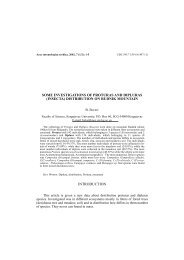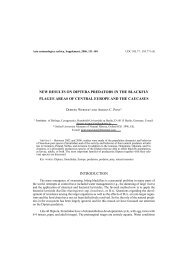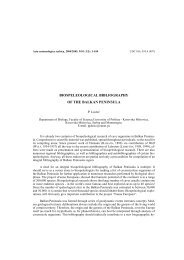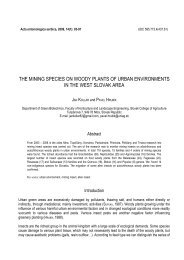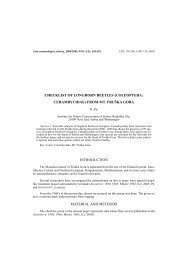Ćetković, A., Mokrousov, M., Plećaš, M., Bogusch, P., Antić, D ...
Ćetković, A., Mokrousov, M., Plećaš, M., Bogusch, P., Antić, D ...
Ćetković, A., Mokrousov, M., Plećaš, M., Bogusch, P., Antić, D ...
Create successful ePaper yourself
Turn your PDF publications into a flip-book with our unique Google optimized e-Paper software.
94 A. ĆETKOVIĆ et al.<br />
All our identifications are based on recent comprehensive treatments (HENSEN, 1987; SCHMID-EGGER, 2005;<br />
BITSCH & BARBIER, 2006), but with the improved interpretation of some characters resulting from this study.<br />
Taxonomic improvements are particularly relevant for the identification from photographs; a wider taxonomic<br />
treatment that resulted from our survey will be published separately (ĆETKOVIĆ et al., unpublished).<br />
Results<br />
In total, we studied 93 specimens of S. deforme (49♀ 44♂) and 100 specimens of S. curvatum (84♀ 16♂)<br />
from the focal areas (listed herewith), as well as numerous additional specimens of S. curvatum from central<br />
Europe (Austria, Czech Republic, Slovakia; not listed), and a few available specimens of S. deforme from<br />
Asia (China, Japan: 6♀ 1♂; not listed); a few were included only from the observations of adults. About 10<br />
specimens are listed from internet-based sources (1♀ of S. deforme, 6♀ of S. curvatum and 3♀ of<br />
ambiguous identity; see the elaboration below), and many more are only mapped (from the countries outside<br />
the focal areas).<br />
We are presenting all the available data for the area extending from the westernmost Balkans, through<br />
Ukraine and European Russia to western/central Asia, both as a list of records and in two respective detailed<br />
maps (Figs. 2 & 3). Records based on the material we studied are presented in full detail, and the already<br />
published data are conveniently condensed. All the listed records, as well as most of the available data for<br />
Europe, are also presented in a large scale synoptic map (Fig. 1). This map is intended to be as<br />
comprehensive as possible, particularly with respect to the recently colonised peripheral areas of the<br />
expanding allochtonous range of S. curvatum; however, it is certainly not exhaustive, since new records are<br />
accumulating quite rapidly in some better covered areas. A selection of the most characteristic years of first<br />
detections for each alien species across Europe is shown, marking the observed “milestones” in the<br />
respective range limits expansion in different directions; the three expansion centres, as initially detected, are<br />
emphasised: Austria – 1979, Russia – 1984, and Montenegro – 2002 (the latter one dubiously, see below).<br />
We mapped, as exactly as possible, about 270 different localities, from 27 countries of Eurasia (with only 7<br />
Asian countries being within the respective native ranges of the two species); both kind of occurrences now<br />
exist in Russia, so we listed separately its European and Asian part. Also, we listed several erroneous<br />
country records for S. deforme (and elaborated in respective section). The approximate total longitudinal<br />
span of the (combined) allochtonous ranges of the two alien species in Europe currently exceeds 4,000 km,<br />
and both species are gradually approaching the westernmost limits of their respective natural ranges in Asia.<br />
Sceliphron deforme (Smith, 1856)<br />
Montenegro. Material: Ulcinj County, Vladimir Village, 26.08.2002. (leg. <strong>Ćetković</strong> A.): 3♀ [ĆETK] + several<br />
more observed collecting mud (reported in: ĆETKOVIĆ et al., 2004).<br />
Greece: Material: Corfu Isl., Dasia, 21.06.2011 (leg. <strong>Antić</strong> D.): numerous nest-cells and several adults<br />
observed in the room of a tourist resort house, 1♀ 1♂ reared from collected cells [ĆETK].<br />
Russia (European). Material: Nizhegorodskaya Oblast: Arzamas Reg., Staraya Pustyn Village, 18.07.1984<br />
(leg. Krivonogov): 2♀, 12.06.1986 (leg. Krivonogov): 1♂; (all others from this locality are leg. <strong>Mokrousov</strong> M.):<br />
19.07.2000: 7♀ 1♂, 27.07.2000: 4♂, 02.07.2001: 1♀ 1♂, 07.07.2001: 1♀ 4♂, 27.06.2002: 1♂,<br />
04.07.2003: 3♀ 4♂, 14.07.2003: 1♂, 16.07.2003: 3♂, 18.07.2003: 1♀, 20.07.2003: 1♂, 23-24.07.2003: 1♀<br />
1♂, 16.08.2003: 4♀, 20.08.2003: 1♀, 07.07.2004: 3♂, 14-15.07.2004: 1♀ 1♂, 21.07.2004: 1♀,<br />
24.07.2004: 1♂, 19.07.2005: 1♀ 1♂, 26.07.2005: 3♀, 29.07.2005: 2♀, 20.07.2008: 2♂, 12.07.2010: 1♀,



